法国混凝土标准详述
法国混凝土标准详述(doc 53页)

法国混凝土标准详述(doc 53页)编号 中文名称 英文名称NF A03-720-1-2002 混凝土的加筋和预应力用钢.试验方法.第1部分:加筋棒、钢丝杆和钢丝 (Steel for the reinforcement and prestressing of concrete - Test methods - Part 1 : reinforcing bars, wire rod and wire.)NF A03-720-2-2002 混凝土的钢筋和预应力用钢.试验方法.第2部分:焊接纤维(Steel for the reinforcement and prestressing of concrete - Test methods - Part 2 : welded fabric.) NF A03-720-3-2002 混凝土的钢筋和预应力用钢.试验方法.第3部分:预应力钢(Steel for the reinforcement and prestressing of concrete - Test methods - Part 3 : prestressing steels.) NF A05-668-2000 混凝土中钢筋的阴极保护 (Cathodic protection of steel in concrete.)NF A35-015-1996 钢筋混凝土用钢筋.可焊光面钢筋(Concrete reinforcing steels. Weldable round bars.)NF A35-016-1996 钢筋混凝土用钢筋.等级为FeE500的可焊带筋钢条和钢旋管.由这些钢筋制成的钢筋网 (Concrete reinforcing steels. Weldable ribbed bars and coils of grade FeE500. Fabric made of these reinforcements.)NF A35-017-1996 (Concrete reinforcing steels. Non weldable ribbed bars and wire rods.)NF A35-018-1984 (Concrete reinforcing bars. Suitability for welding.)NF A35-019-1-1996 (Concrete reinforcing steels. Reinforcing steels made of weldable indented wires. Part 1 : bars and coils.)NF A35-019-2-1996 (Concrete reinforcing steels. Reinforcing steels made of weldable indented wires. Part 2 : welded fabric.)NF A35-021-1998 (STEELS FOR CONCRETE. WELDABLE WIRES USED FOR THE FABRICATION OF REINFORCING STEELS.)NF A35-024-1998 (Steels for concrete. Fabric composed of wires with a diameter lower than 5 mm.)NF A35-027-2003 (Steel products for reinforced concrete - Reinforcements.)NF A35-030-1996 (Steel products. Bars with improved bond for concrete poles, supports for over head lines.)NF A49-160-1979 钢管.混凝土包的加热板用的焊接钢管.(尺寸.交货技术条件.)(STEEL TUBES. WELDED TUBES FORHEATING PANELS ENCASED IN CONCRETE.DIMENSIONS. TECHNICAL DELIVERYCONDITIONS.)NF B40-376-1986 耐火制品.非异型预制材料.密实和隔热的混凝土.稠度试验(Refractory products. Preparedunshaped materials. Dense andinsulating castables. Consistencytest.)NF B51-300-1995 混凝土连(CEMENT-BONDED PARTICLEBOARDS.接碎料板.硬体冲击阻力测定DETERMINATION OF HARD BODY IMPACT RESISTANCE. (EUROPEAN STANDARD EN 1128).)NF B51-301-1996 混凝土连接碎料板.耐霜冻性的测定(Cement bonded particleboards.Determination of frost resistance.)NF C67-200-1981 架空线支柱.钢筋混凝土电杆.规格(Supports for overhead lines.Reinforced concrete poles.Specification.)NF C67-250-1981 架空线.支柱.预应力混凝土电杆.规格(Supports for overhead lines.Prestressed concrete poles.Specification.)NF E58-610-2000 由混凝土和钙硅而来的构架产品生产的机器.安全.第1部分:共同要求(Machines for the manufacture ofconstructional products fromconcrete and calcium-silicate -Safety - Part 1 : commonrequirements.)NF E58-620-2003 混凝土和硅酸钙类建筑产品用生产机器.安全.第2部分:制块机(Machines for the manufacture ofconstructional products fromconcrete and calcium-silicate -Safety - Part 2 : block makingmachines.)NF E58-630-2003 混凝土和硅酸钙类建筑产品用生产机器.安全.第3部分:滑动和转盘机(Machines for the manufacture ofconstructional products fromconcrete and calcium-silicate -Safety - Part 3 : slide and turntablemachines.)NF E58-640-2001 生产混凝(Machines for the manufacture of土和硅酸盐建筑产品用机器.安全.第4部分:屋面砖制造设备constructional products from concrete and calcium-silicate - Safety - Part 4 : rooftile making machines.) NF E58-680-2003 混凝土和硅酸钙类建筑产品用生产机器.安全.第8部分:硅酸盐(和混凝土)建筑产品用生产机器和设备(Machines for the manufacture of constructional products from concrete and calcium-silicate - Safety - Part 8 : machines and equipment for the manufacture of constructional products from calcium-silica) NF F50-051-2-2003 铁路设备.轨道.紧固系统的性能要求.第2部分:混凝土轨枕的紧固系统 (Railway applications - Track - Performance requirements for fastening systems - Part 2 : fastening systems for concrete sleepers.)NF F51-101-1-2003 铁路设施.轨道.混凝土枕木和支撑架.第1部分:一般要求(Railway applications - Track - Concrete sleepers and bearers - Part 1 : general requirements.) NF F51-101-2-2003 铁路设施.轨道.混凝土枕木和支撑架.第2部分:加预应力的单块枕木(Railway applications - Track -Concrete sleepers and bearers - Part2 : prestressed monoblock sleepers.)NF F51-101-3-2003 铁路设施.(Railway applications - Track -轨道.混凝土枕木和支撑架.第3部分:加筋双块枕木Concrete sleepers and bearers - Part3 : twinblock reinforced sleepers.)NF F51-101-4-2003 铁路设施.轨道.混凝土枕木和支撑架.第4部分:道岔和交叉路用支撑架 (Railway applications - Track - Concrete sleepers and bearers - Part 4 : prestressed bearers for switches and crossings.)NF F51-101-5-2003 铁路设施.轨道.混凝土枕木和支撑架.第5部分:特殊构件(Railway applications - Track - Concrete sleepers and bearers - Part 5 : special elements.) NF F54-016-1973 铁路固定设备.信号装置.钢索传动.钢筋混凝土桩(FIXED RAILWAY INSTALLATIONS.SIGNALLING. WIRE TRANSMISSIONS.REINFORCED CONCRETE PICKETS.)NF F55-050-1976 铁路固定设备.嵌入钢筋混凝土的轻型槽电缆导管系统 (FIXED RAILWAY INSTALLATIONS. SYSTEMS FOR LIGHT GAUGE ELECTRIC CABLE CONDUITS SET IN REINFORCED CONCRETE.)NF F55-051-1976 铁路固定设备.地下电缆用钢筋混凝土轻型槽构件(FIXED RAILWAY INSTALLATIONS. LIGHT GAUGE CONDUIT SET IN REINFORCED CONCRETE AND PVC CHANNELLING.) NF F55-0511-1978 铁路固定设备.地下()筋混凝土轻型槽构件.补充件1NF F55-052-1976 铁路固定设备.钢筋混凝土轻型槽(FIXED RAILWAY INSTALLATIONS. LIGHTGAUGE CONDUIT UNITS SET INREINFORCED CONCRETE.)NF F55-053-1976 铁路固定设备.钢筋混凝土轮型槽盖(FIXED RAILWAY INSTALLATIONS. COVERFOR CONDUIT UNITS SET IN REINFORCEDCONCRETE.)NF F55-0531-1978 铁路固定设备.钢筋混凝土轮型槽盖.补充件1()NF F55-071-1990 铁路固定设备.钢筋混凝土预制电缆沟(RAILWAY FIXED EQUIPMENT.PREFABRICATED CABLE PITS,INREINFORCED CONCRETE.)NF F55-100-1975 铁路固定设备.地下电缆用钢筋混凝土制小槽.组件和安装(FIXED RAILWAY INSTALLATIONS.COMPACT DUCTING IN REINFORCEDCONCRETE FOR ELECTRIC CABLES.)NF F55-101-1975 铁路固定设备.地下照明电缆用钢筋混凝土小槽.直线槽构件(FIXED RAILWAY INSTALLATIONS.COMPACT DUCTING IN REINFORCEDCONCRETE FOR ELECTRIC CABLES.STRAIGHT UNITS.)NF F55-102-1975 铁路固定设备.地下照明电缆用钢筋混(FIXED RAILWAY INSTALLATIONS.COMPACT DUCTING IN REINFORCEDCONCRETE FOR ELECTRIC LIGHTINGCABLES. COVERS FOR STRAIGHT UNITS.)直线槽盖NF F55-103-1975 铁路固定设备.地下照明电缆用钢筋混凝土小槽.90°弯槽体(FIXED RAILWAY INSTALLATIONS.COMPACT DUCTING IN REINFORCEDCONCRETE FOR ELECTRIC LIGHTINGCABLES. 90 DEGREES ELBOWS.)NF F55-104-1975 铁路固定设备.地下照明电缆用钢筋混凝土小槽.90°弯槽盖(FIXED RAILWAY INSTALLATIONS.COMPACT DUCTING IN REINFORCEDCONCRETE FOR ELECTRIC LIGHTINGCABLES. COVERS FOR 90 DEGREESELBOWS.)NF F55-105-1975 铁路固定设备.地下照明电缆用钢筋混凝土小槽.电缆终端盒(FIXED RAILWAY INSTALLATIONS.COMPACT DUCTING IN REINFORCEDCONCRETE FOR ELECTRIC LIGHTINGCABLES. VERTICAL BENDS.)NF F55-106-1975 铁路固定设备.地下照明电缆用钢筋混凝土小槽.电缆终端盒盖(FIXED RAILWAY INSTALLATIONS.COMPACT DUCTING IN REINFORCEDCONCRETE FOR ELECTRIC LIGHTINGCABLES. COVERS FOR VERTICAL BENDS.)NF F55-107-1975 铁路固定设备.地下照明电缆用钢筋混凝土小槽.电缆终端盒用固定铁块(FIXED RAILWAY INSTALLATIONS.COMPACT DUCTING IN REINFORCEDCONCRETE FOR ELECTRIC LIGHTINGCABLES. STIRRUPS FOR SECURINGVERTICAL BEND COVERS.)NF F55-110-1975 铁路固定(FIXED RAILWAY INSTALLATIONS.设备.地下牵引电缆用钢筋混凝土小槽.直线槽构件COMPACT DUCTING IN REINFORCED CONCRETE FOR ELECTRIC TRACTION CABLES. STRAIGHT UNITS.)NF F55-111-1975 铁路固定设备.地下牵引电缆用钢筋混凝土小槽.直线槽盖(FIXED RAILWAY INSTALLATIONS.COMPACT DUCTING IN REINFORCEDCONCRETE FOR ELECTRIC TRACTIONCABLES. COVERS FOR STRAIGHT UNITS.)NF F55-112-1975 铁路固定设备.地下牵引电缆用钢筋混凝土小槽.90°弯槽体(FIXED RAILWAY INSTALLATIONS.COMPACT DUCTING IN REINFORCEDCONCRETE FOR ELECTRIC TRACTIONCABLES. 90 DEGREES ELBOWS.)NF F55-113-1975 铁路固定设备.地下牵引电缆用钢筋混凝土小槽.90°弯槽盖(FIXED RAILWAY INSTALLATIONS.COMPACT DUCTING IN REINFORCEDCONCRETE FOR ELECTRIC TRACTIONCABLES. COVERS FOR 90 DEGREESELBOWS.)NF F55-114-1975 铁路固定设备.地下牵引电缆用钢筋混凝土小槽.电缆终端盒(FIXED RAILWAY INSTALLATIONS.COMPACT DUCTING IN REINFORCEDCONCRETE FOR ELECTRIC TRACTIONCABLES. VERTICAL BENDS.)NF F55-115-1975 铁路固定设备.地下牵引电缆用钢筋混凝土小槽.电缆终端盒盖(FIXED RAILWAY INSTALLATIONS.COMPACT DUCTING IN REINFORCEDCONCRETE FOR ELECTRIC TRACTIONCABLES. COVERS FOR VERTICAL BENDS.)NF F55-116-1975 设备.地下牵引电缆用钢筋混凝土小槽.电缆终端盒盖用固定铁块(FIXED RAILWAY INSTALLATIONS.COMPACT DUCTING IN REINFORCEDCONCRETE FOR ELECTRIC TRACTIONCABLES. STIRRUPS FOR SECURINGVERTICAL BEND COVERS.)NF F55-120-1975 铁路固定设备.地下牵引电缆用钢筋混凝土小槽.安装槽用铁块(FIXED RAILWAY INSTALLATIONS.COMPACT DUCTING IN REINFORCEDCONCRETE FOR ELECTRIC TRACTIONCABLES. METAL FASTENERS FORDUCTING.)NF F56-002-1982 铁路固定设备.钢筋混凝土制底座和底座构件(FIXED RAILWAY INSTALLATIONS.EQUIPMENT FOR OVERHEADTELECOMMUNICATION AND SIGNALLINGLINES. REINFORCED CONCRETE SOCLES.)NF F56-131-1991 铁路固定设备.无混凝土保护土的地下电缆保护用导线管(FIXED RAILWAY EQUIPMENT. CONDUITSFOR PROTECTION OF UNDERGROUNDELECTRICAL INSTALLATIONS,WITHOUTCONCRETE CASING.)NF F56-153-1978 铁路固定设备.通讯和信号装置架空线路用器材.钢筋混凝土电杆钭撑用卡箍(FIXED RAILWAY INSTALLATIONS.EQUIPMENT FOR OVERHEADTELECOMMUNICATION AND SIGNALLINGLINES. BRACING COLLARS FORREINFORCED CONCRETE POSTS.)NF F56-210-1980 铁路固定设备.通讯和信号装置架空线路用器材.钢筋混凝(FIXED RAILWAY INSTALLATIONS.EQUIPMENT FOR OVERHEADTELECOMMUNICATION AND SIGNALLINGLINES. SMALL COUPLING PLATES FORREINFORCED CONCRETE SOCKETS.)安装板NF F56-211-1980 铁路固定设备.通讯和信号装置架空线路用器材.钢筋混凝土底座用安装片(FIXED RAILWAY INSTALLATIONS.EQUIPMENT FOR OVERHEADTELECOMMUNICATION AND SIGNALLINGLINES. SMALL SECURING PLATES FORREINFORCED CONCRETE SOCKETS.)NF F56-338-1982 铁路固定设备.通讯和信号装置架空线路用器材.钢筋混凝土电杆上横撑固定用板(FIXED RAILWAY INSTALLATIONS.EQUIPMENT FOR OVERHEADTELECOMMUNICATION AND SIGNALLINGLINES. PLATE FOR SECURINGCROSS-PIECES TO REINFORCED CONCRETEPOSTS.)NF M88-516-1979 钢制贮罐.液态石油产品地下贮存用带混凝土外壳的地下贮罐(STEEL TANKS WITH OUTSIDE CONCRETECOATING FOR UNDERGROUND STORAGE OFMINERAL OILS.)NF P02-016-1993 建筑物和土木工程结构图.钢筋混凝土用钢筋.造型.编码.圆棒.棒材、线材及高粘合线材(BUILDING AND CIVIL ENGINEERINGDRAWINGS. CONCRETE REINFORCEMENTS.MANUFACTURE. CODING. ROUND BARS.BARS, WIRES AND WIRE ROD WITHIMPROVED ADHERENCE.)NF P12-002-2001 圬工单位的试验方法.第2部分:集成混(Specification for masonry units -Part 2 : calcium silicate masonryunits.)设施中空隙面积百分比的测定(纸刻痕法)NF P12-004-2001 圬工单位的试验方法.第4部分:用压热器加工的混凝土砖(Specification for masonry units -Part 4 : autoclaved aerated concretemasonry units.)NF P12-102-1999 圬工设施的试验方法.第2部分:集成混凝土圬工设施中空隙面积百分比的测定(纸刻痕法)(Methods of test for masonry units.Part 2 : determination of percentagearea of voids in aggregate concretemasonry units (by paperindentation).)NF P12-106-2002 圬工单位的试验方法.第6部分:集料混凝土圬工单位的抗弯曲拉伸强度的测定(Methods of test for masonry units -Part 6 : determination of bendingtensile strength of aggregateconcrete masonry units.)NF P12-110-1999 砖石结构试验方法.第10部分:硅酸钙和压热通风混凝土结构水分含量的测定(欧洲标准EN(Methods of test for masonry units.Part 10 : determination of moisturecontent of calcium silicate andautoclaved aerated concrete units.)NF P12-111-2001 圬工单位的试验方法.第11部分:集料混凝土,加工石材和天然石材圬工单位由于毛细作用的水吸收的测定及石膏圬(Methods of test for masonry units -Part 11 : determination of waterabsorption of aggregate concrete,manufactured stone and natural stonemasonry units due to capillaryaction and the initial rate o)NF P12-114-2002 圬工单位的试验方法.第14部分:集料混凝土和人造石圬工单位湿度变形的测定(Methods of test for masonry units -Part 14 : determination of moisturemovement of aggregate concrete andmanufactured stone masonry units.)NF P12-115-2001 圬工单位的试验方法.第15部分:蒸压充气混凝土圬工单位水蒸汽渗透性的测定(Methods of test for masonry units -Part 15 : determination of watervapour permeability of autoclavedaerated concrete masonry units.)NF P12-120-2001 圬工单位的试验方法.第20部分:集料混凝土,加工石材和天然石材圬工单位的表面平(Methods of test for masonry units -Part 20 : determination of flatnessof faces of aggregate concrete,manufactured stone and natural stonemasonry units.)定NF P13-302-1983 地板用带预制混凝土桁条的陶土空心砖(Hollow clay blocks for floors madewith precast concrete beams.)NF P14-101-1983 墙和隔墙用混凝土块.定义(Concrete blocks for walls andpartitions. Definitions.)NF P14-402-1983 砌块.在墙和隔墙混凝土砖.尺寸(Concrete blocks for walls andpartitions. Dimensions.)NF P15-318-1998 用于预拉伸混凝土的有限硫化物含量的混凝土.水力胶合剂(Hydraulic binders. Cement withlimited sulphides content for use inprestressed concrete.)NF P16-306-2000 建筑物排放系统的纤维混凝土管线和配件.交货的尺寸和技术条款(Fibre-cement pipes and fiftings fordischarge systems for buildings -Dimensions and technical terms ofdelivery.)NF P16-341-1990 排水.无压力排水管路用钢筋混凝土和非钢筋混凝土制圆管.定义、规范、试验方法、标记、验收条件(Drainage, sewerage. Precastconcrete cylindrical pipes, steelreinforced or not reinforced forsewerage networks without pressure.Definitions, specifications,testing methods, marking, basis foracceptance.)NF P16-342-1990 管道上的混凝土制观察孔用的在工厂加工构件.定义、规范、试验方法、标记、验收条件(DRAINAGE,SEWERAGE. PRECAST CONCRETE ELEMENTS OF MANHOLES FOR SEWAERAGE NETWORKS. DEFINITIONS SPECIFICATIONS,TESTING METHODS,MARKING,BASIS FOR ACCEPTANCE.) NF P16-343-1990 排水.排水管的混凝土制接线盒用工厂加工的元件.定义、规范、试验方法、标记、验收条件 (DRAINAGE,SEWERAGE. PRECAST CONCRETE ELEMENTS OF LAMPHOLES FOR SEWERAGE NETWORKS. DEFINITIONS,SPECIFICATIONS,TESTING METHODS,MARKING,BASIS FOR ACCEPTANCE.)NF P16-345-1-2003 非加筋、钢筋和加筋混凝土管道和配件(Concrete pipes and fittings, unreinforced, steel fibre and reinforced.) NF P16-345-2-2003 非加筋、钢筋和加筋混凝土管道和配件.第2部分:国家规范 (Concrete pipes and fittings, unreinforced, steel fibre and reinforced - Part 2 : national specification.)NF P16-346-1-2003 非加筋、钢筋和加筋混凝土检查井和检查室(Concrete manholes and inspectionchambers, unreinforced, steel fibreand reinforced.)NF P16-346-2-2003 非加筋、钢筋和加筋混凝土检查井和检查室.第2(Concrete manholes and inspection chambers, unreinforced, steel fibre and reinforced - Part 2 : National specification.)规范NF P18-010-1985 混凝土.水硬性混凝土的名称和分类(CONCRETE. CLASSIFICATION ANDDESIGNATION OF HYDRAULIC CONCRETE.)NF P18-050-1995 混凝土飞灰的定义,要求和质量管理(Fly ash for concrete. Definitions,requirements and quality control.)NF P18-140-1996 预应力钢筋混凝土构件用的泥浆.普通泥浆规范(Grout for prestressing tendons.Specification for common grout.)NF P18-141-1996 预应力钢筋混凝土构件用的泥浆的试验方法(Grout for prestressing tendons.Test methods.)NF P18-142-1996 预应力钢筋混凝土构件用的泥浆的灌浆程序(Grout for prestressing tendons.Grouting procedures.)NF P18-160-1997 预应力钢筋混凝土构件用钢筋鞘管.术语、要求和质量控制(欧洲标准EN 523)(Steel strip sheaths forprestressing tendons. Terminology,requirements, quality control.)NF P18-161-1997 预应力钢筋混凝土构件用钢筋鞘管.试验方法.第1部分:形(Steel strip sheaths forprestressing tendons. Test methods.Part 1 : determination of shape anddimensions.)的测定(欧洲标准EN 524-1)NF P18-162-1997 预应力钢筋混凝土构件用钢筋鞘管.试验方法.第2部分:挠性测定(欧洲标准EN524-2)(Steel strip sheaths forprestressing tendons. Test methods.Part 2 : determination of flexuralbehaviour.)NF P18-163-1997 预应力钢筋混凝土构件用钢筋鞘管.试验方法.第3部分:往复弯曲试验(欧洲标准EN524-3)(Steel strip sheaths forprestressing tendons. Test methods.Part 3 : to-and-fro bending test.)NF P18-164-1997 预应力钢筋混凝土构件用钢筋鞘管.试验方法.第4部分:侧面负荷阻力的测定(欧洲标准EN 524-4)(Steel strip sheaths forprestressing tendons. Test methods.Part 4 : determination of lateralload resistance.)NF P18-165-1997 预应力钢筋混凝土构件用钢筋鞘管.试验方法.第5部分:拉伸阻力的测定(欧洲(Steel strip sheaths forprestressing tendons. Test methods.Part 5 : determination of tensileload resistance.)524-5)NF P18-166-1997 预应力钢筋混凝土构件用钢筋鞘管.试验方法.第6部分:水损失的测定(欧洲标准EN524-6)(Steel strip sheaths forprestressing tendons. Test methods.Part 6 : determination ofleaktightness (determination ofwater loss).)NFP18-201/A1-1999 DTU 21.建筑工程.混凝土工程的实施.技术规范(DTU 21 - Building works - Executionof concrete works - Technicalspecifications.)NFP18-201/A2-2001 DTU 21.建筑工程.混凝土工程的实施.技术规范(DTU 21 - Building works - Executionof concrete works - Technicalspecifications.)NF P18-210-1993 DTU 23-1.建筑工程.现场浇灌的混凝土墙.技术规范(DTU 23-1. Building works. In situformed concrete walls. Technicalspecifications.)NF P18-211-2003 混凝土搅拌用水.混凝土搅拌用水(包括混凝土加工过程中回收的水)的适用性的取样、试验、评定规范(Mixing water for concrete -Specification for sampling, testingand assessing the suitability ofwater, including water recoveredfrom processes in the concreteindustry, as mixing water forconcrete.)NF P18-306-1965状熔渣(CONCRETES. GRANULAR SLAG.)NF P18-307-1965 其它混凝土.膨胀矿渣(MISCELLANEOUS CONCRETES. EXPANDEDSLAG.)NF P18-308-1965 其它混凝土.火山灰(MISCELLANEOUS CONCRETES.POZZOLAN.)NF P18-309-1982 集料.转炉制造中用于浇制混凝土膨胀页岩或粘土碎石料(Aggregates. Rotary-furnace madeexpanded clay and shale for makingconcretes.)NF P18-310-1998 混凝土添加剂.砖石和灰浆.试验方法.第1部分:试验用基准混凝土和混凝灰浆(Admixtures for concrete, mortar andgrout. Test methods. Part 1 :reference concrete and referencemortar for testing.)NF P18-311-1996 混凝土、灰泥和薄浆混合料.试验方法.第2部分:凝结时间的测定(Admixtures for concrete, mortar andgrout. Test methods. Part 2 :determination of setting time.)NF P18-313-1996 混凝土、灰泥和薄浆混合料.试验方法.第4部分:混凝土泌水性的测定(Admixtures for concrete, mortar andgrout. Test methods. Part 4 :determination of bleeding ofconcrete.)NF P18-314-1996 混凝土、灰泥和薄浆混合料.试验方法.第(Admixtures for concrete, mortar andgrout. Test methods. Part 5 :determination of capillaryabsorption.)细吸收的测定NF P18-315-1996 混凝土、灰泥和薄浆混合料.试验方法.第6部分:红外线分析(Admixtures for concrete, mortar andgrout. Test methods. Part 6 :infrared analysis.)NF P18-317-1996 混凝土、灰泥和薄浆混合料.试验方法.第8部分:干性物质含量的常规测定(Admixtures for concrete, mortar andgrout. Test methods. Part 8 :determination of the conventionaldry material content.)NF P18-319-1996 混凝土、灰泥和薄浆混合料.试验方法.第10部分:水溶性氯化物的含量测定(Admixtures for concrete, mortar andgrout. Test methods. Part 10 :determination of water solublechloride content.)NF P18-320-1999 混凝土、砂石和灰浆用添加剂.试验方法.第11部分:硬化混凝土中气体空隙特性的测定(Admixtures for concrete, mortar andgrout. Test methods. Part 11 :determination of air voidcharacteristics in hardenedconcrete.)NF P18-321-1998 混凝土添加剂.砖石和灰浆.试验方法.第12部分:添加剂碱(Admixtures for concrete, mortar andgrout. Test methods. Part 12 :determination of the alkali contentof admixtures.)测定NF P18-323-2003 混凝土、灰浆和灌浆混合物.试验方法.第13部分:灰浆混合物测试用标准砌砖灰浆(Admixtures for concrete, mortar andgrout - Test methods - Part 13 :reference masonry mortar for testingmortar admixtures.)NF P18-325-2002 混凝土.第1部分:规范、性能、生产及一致性(Concrete - Part 1 : specification,performance, production andconformity.)NF P18-342-2002 混凝土,灰浆和灌浆外加剂.第2部分:混凝土外加剂,定义,要求,一致性,标记和标签(Admixtures for concrete, mortar andgrout - Part 2 : concrete admixtures- Definitions, requirements,conformity, marking and labelling.)NF P18-344-2002 混凝土、砂浆和灌浆用外加剂.第4部分:预应力钢筋束用外加剂.定义、要求、一致性、标记和标签(Admixtures for concrete, mortar andgrout - Part 4 : admixtures for groutfor prestressing tendons -Definitions, requirements,conformity, marking and labelling.)NF P18-346-2002 混凝土,灰浆和灌浆混合物.第6部分:取样、合格控(Admixtures for concrete, mortar andgrout - Part 6 : sampling, conformitycontrol and evaluation ofconformity.)评定NF P18-350-1986 混凝土、砂浆和灰浆添加剂.标准水泥(Concrete, mortar and groutadmixtures. Reference cements.)NF P18-352-1986 混凝土、砂浆和灰浆添加剂.恒定和易性效率试验添加剂混凝土和砂浆拌和加水量的测定(Concrete, mortar and groutadmixtures. Determination of thewater requirements of concretes andmortars with admixtures whensubjected to performance tests atconstant workability.)NF P18-353-1985 混凝土、砂浆和灰浆添加剂.气量计测定新拌混凝土内封闭空气的百分比(CONCRETE,MORTAR AND GROUTADMIXTURES. MEASUREMENT OF THEPERCENTAGE OF ENTRAINED AIR IN FRESHCONCRETE USING AN AIR METER.)NF P18-370-1995 添加剂.混凝土和砂浆用养护产品.定义,规范和标记(ADMIXTURES. CURING PRODUCTS FORCONCRETE AND MORTAR. DEFINITION,SPECIFICATIONS AND MARKING.)NF P18-371-1995 添加剂.混凝土和砂浆用养护产品.防护系数的测定(ASMIXTURES. CURING PRODUCTS FORCONCRETE AND MORTAR. DETERMINATIONOF PROTECTIVE COEFFICIENT.)NF P18-400-1981 混凝土.圆柱形和三棱形样模(CONCRETES. MOULDS FOR CYLINDRICALAND PRISMATIC TEST SPECIMENS.)NF P18-404-1981 用性和检验研究试验.试样制备和保管(Concretes. Study, suitability andcontrol tests. Manufacture andstorage of test specimens.)NF P18-405-1981 混凝土.信息试验.试样制备和保管(Concretes. Information tests.Manufacture and storage of testspecimens.)NF P18-407-1981 混凝土.弯曲试验(Concretes. Binding test.)NF P18-408-1981 混凝土.劈裂试验(Concretes. SPLIT0ING test.)NF P18-411-1981 混凝土.硬材料弯曲.压缩和拉力试验用液压机的一般特性(Concretes. Common characteristicsof hydraulic machines forcompression, bending, and tensiontesting of hard materials.)NF P18-412-1981 混凝土.硬材料压缩试验用液压机的特殊性能(Concretes. Individual propertiesof hydraulic machines forcompression tests. (presses for hardmaterials).)NF P18-413-1981 混凝土.硬材料弯曲试验用液压机的特殊性能(Concretes. Individual propertiesof hydraulic machines for bendingtests of hard materials.)NF P18-421-1981 混凝土.微型振捣台灌筑(CONCRETES. PLACING BY MEANS OFVIBRATING MICROTABLE.)NF P18-422-1981 混凝土.振捣棒灌筑(Concretes. Placing by means ofvibrating needle.)NF P18-423-1981 混凝土.钎捣灌筑(Concretes. Placing by means ofrodding.)NF P18-427-1996 混凝土.水(CONCRETE. DETERMINATION OF THE硬性混凝土试样两个相对面之间尺寸变化的测定DIMENSIONAL VARIATIONS BETWEEN TWO OPPOSITE FACES OF HARDENED CONCRETE TEST SPECIMENS.)NF P18-430-2001 硬化混凝土试验.第1部分:样品和模型的形状、尺寸和其它要求(Testing hardened concrete - Part 1 :shape, dimensions and otherrequirements for test specimens andmoulds.)NF P18-431-2001 试验用新浇混凝土.第4部分:密实度等级(Testing fresh concrete - Part 4 :degree of compactability.)NF P18-433-2001 硬化混凝土试验.第5部分:试样的弯曲强度(Testing hardened concrete - Part 5 :flexural strength of testspecimens.)NF P18-434-2001 硬化混凝土试验.第6部分:试样的抗拉伸撕裂强度(Testing hardened concrete - Part 6 :tensile splitting strength of testspecimens.)NF P18-435-2001 硬化混凝土试验.第7部分:硬化混凝土密度(Testing hardened concrete - Part 7 :density of hardened concrete.)NF P18-436-2001 硬化混凝土试验.第8部分:加压时水的渗透深度(Testing hardened concrete - Part 8 :depth of penetration of water underpressure.)NF P18-437-1999 土测试.第1部分:取样(Testing fresh concrete - Part 1 :sampling.)NF P18-438-2001 硬化混凝土试验.第2部分:强度试验用样品的制备和养护(Testing hardened concrete - Part 2 :making and curing specimens forstrength tests.)NF P18-441-2000 硬化混凝土试验.第4部分:抗压强度.试验机规范(Testing hardened concrete - Part 4 :compressive strength -Specification for testingmachines.)NF P18-443-2001 试验新鲜混凝土.第7部分:空气含量.压力方法(Testing fresh concrete - Part 7 :air content - Pressure methods.)NF P18-444-2000 结构中的试验混凝土.第1部分:芯样本.压缩时的取样,检验和试验(Testing concrete in structures -Part 1 : cored specimens - Taking,examining and testing incompression.)NF P18-445-2003 结构中的混凝土试验.第2部分:无损检验.回弹数的测定(Testing concrete in structures -Part 2 : non-destructive testing -Determination of rebound number.)NF P18-451-1981 混凝土.塌陷试验(Concrete. Slump test.)NF P18-452-1988 混凝土.和易性测量计测定混凝土流动(CONCRETES. MEASURING THE FLOW TIMEOF CONCRETES AND MORTARS USING AWORKABILITYMETER.)NF P18-455-2003 硬化混凝土试验.第3部分:试样的压缩强度(Testing hardened concrete - Part 3 :compressive strength of testspecimens.)NF P18-500-1995 混凝土.沙型混凝土(Concrete. Sand concrete.)NF P18-501-1992 水硬性混凝土添加剂.填缝料(ADDITIONS FOR CONCRETE. FILLERS.)NF P18-502-1992 混凝土添加剂.硅雾(ADDITIONS FOR CONCRETE. SILICAFUMES.)NF P18-506-1992 水硬性混凝土添加剂.细磨碎的玻璃状渣.炉(ADDITIONS FOR CONCRETE. GROUNDGLASSY BLASTFURNACE SIAG.)NF P18-507-1992 混凝土掺和料.水分保持.用“CONEDEDEMARSH“喷涌测量流动性的方法(ADDITIONS FOR CONCRETE. WATERRETENTION. METHOD FOR MEASUREMENT OFFLUIDITY BY FLOWING WITH THE “CONEDE MARSH“.)NF P18-508-1995 水硬性混凝土添加剂.石灰石填加剂.规范(ADDITIONS FOR CONCRETE. LIMESTONEADDITIONS. SPECIFICATIONS ANDCONFORMITY CRITERIA.)NF P18-509-1998 混凝土粘接剂.硅质添加剂.规范和一致性标准(ADDITIONS FOR CONCRETE. SILICEOUSADDITIONS. SPECIFICATIONS ANDCONFORMITY CRITERIA.)NF P18-601-2003 集料 (Aggregates for concrete.)NF P18-603-1-2002 轻集料.第1部分:混凝土、砂浆和灰浆用轻集料(Lightweight aggregates - Part 1 :lightweight aggregates forconcrete, mortar, and grout.)NF P18-806-1989 水硬性混凝土建筑用的特殊产品.粘结料产品或合成树脂基产品.灰末粒度尺寸的分析(SPECIAL PRODUCTS FOR HYDRAULIC CONCRETE CONSTRUCTIONS. BINDER- OR SINTHETIC RESIN BASED PRODUCTS. PARTICLE SIZE ANALYSIS OF POWDERS.) NF P18-807-1989 水硬性混凝土建筑用的特殊产品.合成树脂或水凝基制品.+450℃时烧失和+950℃灰份含量(SPECIAL PRODUCTS FOR HYDRAULIC CONCRETE CONSTRUCTIONS. SYNTHETIC RESIN OR HYDRAULIC BINDER BASED PRODUCTS. FIRE LOSS AT + 450 DEGREES CELSIUS AND ASH CONTENT AT + 950 DEGREES CELSIUS.) NF P18-810-1989 水硬性混凝土建筑用的特殊产品.合成树脂基产品.使用期限的确定(SPECIAL PRODUCTS FOR HYDRAULIC CONCRETE CONSTRUCTIONS. SYNTHETIC RESIN BASED PRODUCTS. DETERMINATION OF USUAL PRACTICE TIME.) NF P18-874-1989 水硬性混凝土建筑用的特殊产品.粘结两块混凝土的产品.最大粘合(SPECIAL PRODUCTS FOR HYDRAULIC CONCRETE CONSTRUCTIONS. PRODUCTS FOR MAKING STRUCTURAL JOINTS BETWEEN TWO CONCRETE ELEMENTS. TEST FOR DETERMINING THE MAXIMUM ASSEMBLY TIME.)。
Faury水泥混凝土配合比设计方法的应用研究

Faury水泥混凝土配合比设计方法的应用研究范永刚(中铁十四局集团有限公司,济南250014)摘要:Faury法是法国标准里的一种混凝土配合比设计方法。
文章结合海外施工项目阿尔及利亚东西高速公路M1、M2标段水泥混凝土配合比设计,介绍了Faury法配合比设计方法的原理和流程,并运用国标JGJ55-2000(普通混凝土配合比设计规程)对Faury法进行了适当的补充与结合。
关键词:Faury配合比设计应用Abstract:Faury is a kind of concrete mix design method of standard French.This paper combined with the design of Algeria East-West Expressway M1,section M2 cement concrete overseas construction project,introduces the Faury method with the principle and flow design method,and use the JGJ55-2000(Standard Specification for mix proportion design of ordinary concrete)the Faury method was appropriate to supplement and combination.Keywords:design application with Faury中图分类号:TU37文献标识码:A文章编号:1引言阿尔及利亚东西高速公路设计及施工采用的是法国规范。
在法国规范里,混凝土配合比设计方法主要有bolomey法、faury法、vallette法、fuller法和joisel法等。
在阿尔及利亚习惯采用的是Faury法。
这种设计方法与我国JGJ55-2000(普通混凝土配合比设计规程)中的设计方法有着很大的区别。
法国规范-片状指数
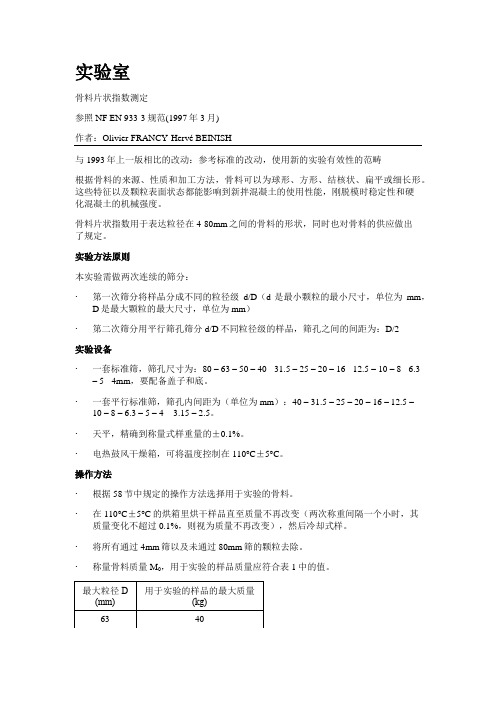
实验室
骨料片状指数测定 参照 NF EN 933-3 规范(1997 年 3 月) 作者:Olivier FRANCY-HervéBEINISH 与 1993 年上一版相比的改动:参考标准的改动,使用新的实验有效性的范畴 根据骨料的来源、性质和加工方法,骨料可以为球形、方形、结核状、扁平或细长形。 这些特征以及颗粒表面状态都能影响到新拌混凝土的使用性能,刚脱模时稳定性和硬 化混凝土的机械强度。 骨料片状指数用于表达粒径在 4-80mm 之间的骨料的形状,同时也对骨料的供应做出 了规定。 实验方法原则 本实验需做两次连续的筛分: 第一次筛分将样品分成不同的粒径级 d/D(d 是最小颗粒的最小尺寸,单位为 mm, D 是最大颗粒的最大尺寸,单位为 mm) 第二次筛分用平行筛孔筛分 d/D 不同粒径级的样品,筛孔之间的间距为:D/2
在制定骨料供应商招标细则时,应详细说明此种碎石实验。在混凝土工业中,推荐不 得超过 20%,最大误差不得超过 5%。 确保供货符合招标细则中的规定是很重要的,例如可以每月对其进行验收实验。 如果凭视觉判断,骨料中片状及针状颗粒的含量较大,并且 A 的值超出了误差范围, 则有必要向供应商反应。
表2 称量每个粒径级 d/D 颗粒相关网眼过筛物的质量,四舍五入到 g:即 Me1, Me2, Me3, 等等,数Байду номын сангаас用克表示。
获得实验结果 即: M=∑Mg,每个级配范围 d/D 材料的质量之和(用 g 表示)。M 的值可略小于 M0,但 是相差不得超过 2%。 M’=∑Me,每个级配范围 d/D 材料中通过相应平行筛孔的料的质量之和。
法国标准(P98-137)BBTM
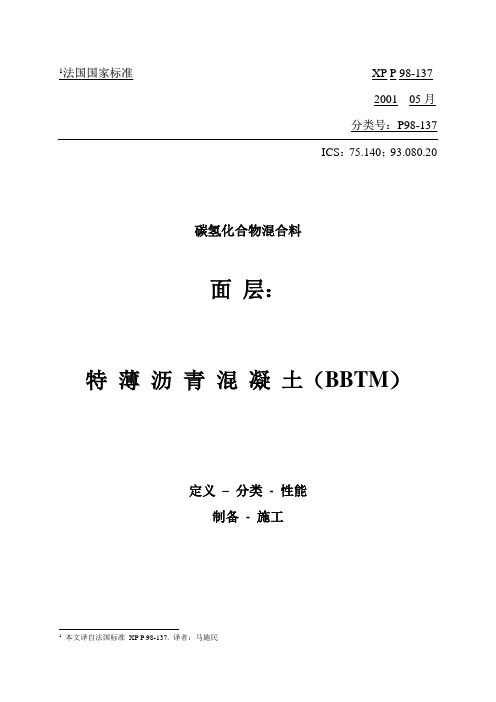
1法国国家标准X P P98-137200105月分类号:P98-137ICS:75.140;93.080.20碳氢化合物混合料面层:特薄沥青混凝土(BBTM)定义–分类- 性能制备- 施工1本文译自法国标准XP P 98-137. 译者:马施民目录1.应用领域2.参考标准3.术语-缩写-分类3.1 术语3.2 缩写-3.3 分类4.使用条件4.1 支承层状况4.2 厚度5.组分特性5.1 骨料5.1.1 粒度性5.1.2 粒级5.1.3 细粒组分5.2 黏合剂5.3 添加剂5.4 集料6.混合料特性6.1 组成6.2 黏合剂含量6.3 配合比试验内容6.4 试验室性能7.制备--鉴别和运输8.施工8.1 预备工作8.2 实施8.2.1 附着层8.2.2 摊铺8.2.3 摊铺厚度9.现场条件9.1 空隙比例9.2 宏观结构1.应用领域本文献的目的在于制定在搅拌中心热拌制成的特薄沥青混凝土的定义,性能确认,为确定性能而采用的相关试验。
然后,规范其制备条件与漏斗式供货条件以及NF P98-150标准中未定义的运输和制备操作。
特薄沥青混凝土是一类碳氢化合物混合料,其特征在于一定比例的砾石含量和适用于平均厚度在20~30mm之间的组成。
这类材料主要在道路的建设,加固或维护情况下用于建造面层。
这类材料属于混合物,由碳氢化合物黏合剂,骨料和可能的添加剂配成。
2.参照标准本文献包含了其他出版物中列举的有日期标记和无日期标记的标准。
这些参照标准在正文中的适当地方出现并按以下顺序编号。
对于有日期标记的标准,这些出版物中的任何一个最新修正条款或修订条款仅在其已编入这些文献的情况下才适用于本文献。
至于无日期标记的标准,则已该出版物的最新版本为标准。
NF EN 933-9,骨料---确定骨料几何特征的试验---第9部分:针对细粒土的试验---亚甲兰试验(类别指数:P18-622-9)。
XP P 18-540,骨料-定义-合格要求。
欧洲及法国的建筑和土木工程技术标准简介
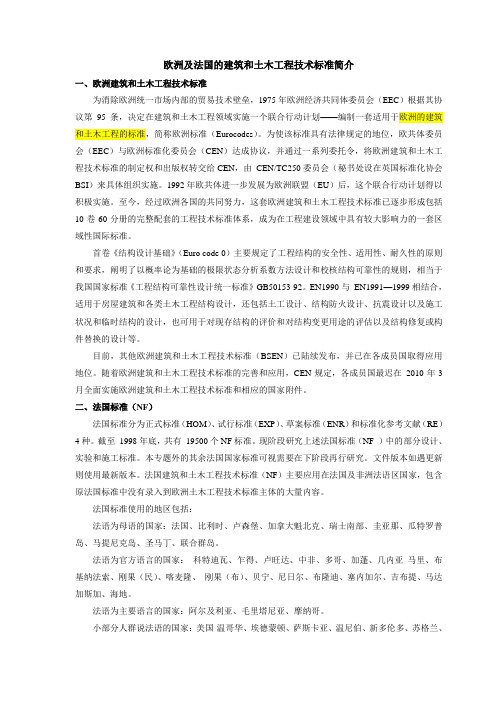
欧洲及法国的建筑和土木工程技术标准简介一、欧洲建筑和土木工程技术标准为消除欧洲统一市场内部的贸易技术壁垒,1975年欧洲经济共同体委员会(EEC)根据其协议第95条,决定在建筑和土木工程领域实施一个联合行动计划——编制一套适用于欧洲的建筑和土木工程的标准,简称欧洲标准(Eurocodes)。
为使该标准具有法律规定的地位,欧共体委员会(EEC)与欧洲标准化委员会(CEN)达成协议,并通过一系列委托令,将欧洲建筑和土木工程技术标准的制定权和出版权转交给CEN,由CEN/TC250委员会(秘书处设在英国标准化协会BSI)来具体组织实施。
1992年欧共体进一步发展为欧洲联盟(EU)后,这个联合行动计划得以积极实施。
至今,经过欧洲各国的共同努力,这套欧洲建筑和土木工程技术标准已逐步形成包括10卷60分册的完整配套的工程技术标准体系,成为在工程建设领域中具有较大影响力的一套区域性国际标准。
首卷《结构设计基础》(Euro code 0)主要规定了工程结构的安全性、适用性、耐久性的原则和要求,阐明了以概率论为基础的极限状态分析系数方法设计和校核结构可靠性的规则,相当于我国国家标准《工程结构可靠性设计统一标准》GB50153-92。
EN1990与EN1991—1999相结合,适用于房屋建筑和各类土木工程结构设计,还包括土工设计、结构防火设计、抗震设计以及施工状况和临时结构的设计,也可用于对现存结构的评价和对结构变更用途的评估以及结构修复或构件替换的设计等。
目前,其他欧洲建筑和土木工程技术标准(BSEN)已陆续发布,并已在各成员国取得应用地位。
随着欧洲建筑和土木工程技术标准的完善和应用,CEN规定,各成员国最迟在2010年3月全面实施欧洲建筑和土木工程技术标准和相应的国家附件。
二、法国标准(NF)法国标准分为正式标准(HOM)、试行标准(EXP)、草案标准(ENR)和标准化参考文献(RE)4种。
截至1998年底,共有19500个NF标准。
法国混凝土标准详述
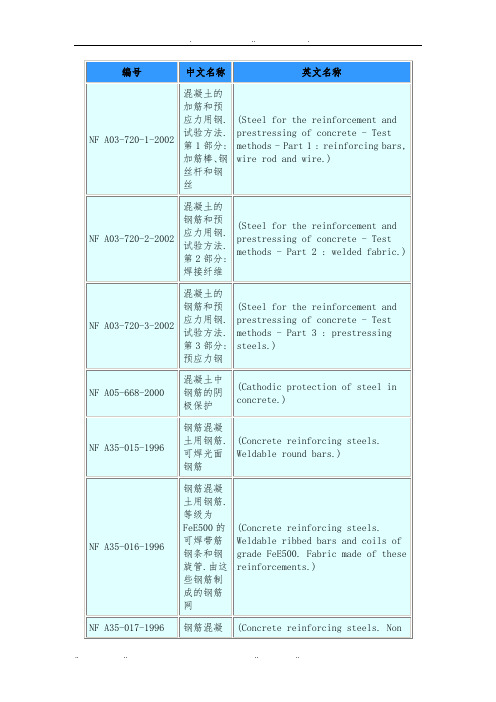
NF E58-630-2003
NF A35-018-1984
钢筋混凝土用钢筋.焊接的适合性
(Concrete reinforcing bars. Suitability for welding.)
NF A35-019-1-1996
钢筋混凝土用钢筋.可焊刻痕丝制钢筋.第1部分:钢条和旋管
(Concrete reinforcing steels. Reinforcing steels made of weldable indented wires. Part 1 : bars and coils.)
NF F51-101-5-2003
铁路设施.轨道.混凝土枕木和支撑架.第5部分:特殊构件
(Railway applications - Track - Concrete sleepers and bearers - Part 5 : special elements.)
NF F54-016-1973
NF A35-030-1996
钢制品.架空线路支持的混凝土杆用带改进粘附性的棒材
(Steel products. Bars with improved bond for concrete poles, supports for over head lines.)
NF A49-160-1979
钢管.混凝土包的加热板用的焊接钢管.(尺寸.交货技术条件.)
NF F55-0511-1978
法国标准NF P 18-011资料

法国标准NF P 18-0111992年6月混凝土所处侵蚀环境的分类英语:混凝土所处侵蚀环境的分类德语:混凝土所处侵蚀环境的分类1992年6月由法国标准化协会出版的文献分册替换1985年相同参号的文献分册对应性:本文件出版之日存在与本文件主题相同的欧洲工程。
本文献分册加入了混凝土所处环境侵蚀等级定义,为了保证混凝土强度等级,对在该环境下混凝土的制作提出了防范措施建议。
在本文件编制的过程之中参考了国外出版物以及欧洲和国际工程,尽管专家们对选取的限值有很大的争议,但是仍然可以从中看出文件的益处。
描述符国际技术词汇分类汇编:建设材料,钢筋混凝土,预应力混凝土,强度,分类,环境,自然物质侵蚀防护,保护措施,化学侵蚀,淡水,酸性环境,碱性环境,海水,盐度,铁,固态气体,参数表修订:与之前的版本相比做了一些修订,详见表5、6、7.标准化委员会成员主席:TUTENUIT先生秘书:FERNANDEZ女士法国标准化协会ADAM先生咨询工程师ALEXANDRE先生贸易政策和法律中心BESSET先生SNBPEBILLHOUET先生SABLOCRETEBOUINEAU先生建筑公共工程研究及试验中心BOUTIN先生SOCOTECBROCHERIEUX先生SPIE BATIGINOLLESBRUSIN先生CERIBCHARONNAT先生法国地质学科委员会CLAUZON先生瓦工工程国家协会COQUILLAT先生建筑公共工程研究及试验中心DELORT先生ATILHGALLET先生EDFGROS JEAN先生CH SYND ENTREPRENEURSHAWTHORN先生UNIMIXJACQUES先生法国地质学科委员会LAINEFIB先生LARAVOIRE先生DAEILECAM先生EDF GDFLESAGE先生法国地质学科委员会MARMOTTAN女士SABLOCRETEMIERSMAN先生SURSCHISTE SAMONACHON先生CAMPENON BERNARDNOVAK先生SIKA SAPAILLERE女士法国地质学科委员会PLUMAT ATILHPOITEVIN先生咨询工程师SCHMOL先生SNBATITHONIER先生FNTPTUTENUIT先生CONSEIL GENERAL DES PONTS ET CHAUSSEES VAUTRIN先生SETRAVINCENSINI小姐法国标准化协会目录一、目的 (4)二、参考文献 (4)三、概论 (4)四、侵蚀环境类型和归因 (5)五、侵蚀环境等级 (6)六、侵蚀环境的影响方式 (7)6.1、液体 (7)6.1.1、淡水 (7)6.1.2、酸溶液 (8)6.1.3、碱溶液 (8)6.1.4、盐溶液 (8)6.1.5、海水的特殊情况 (9)6.1.6、油脂和油的特殊情况 (9)6.1.7、来自于内部的侵蚀的特殊情况:骨料-碱反应 (10)6.2、气体 (11)6.2.1、亚硫酸SO2 (11)6.2.3、碳酸C O2 (11)6.3、固体 (11)七、建议 (12)7.1、一般建议 (12)7.2、特别建议 (13)八、参考文献 (14)一、目的本文献分册目的为:-确定钢筋混凝土和预应力混凝土的最普通的侵蚀环境,-使用在侵蚀环境中混凝土制作的抗腐蚀性方面的建议。
法国混凝土配合比设计方法及应用_苏格兰

48 国 外 公 路 第19卷 第5期1999年10月 文章编号:1003-6512(1999)05-0048-06法国混凝土配合比设计方法及应用苏格兰(湖南省高速公路公司,湖南长沙 410011) 摘 要:文中介绍了法国水泥混凝土配合比设计方法,提供了配合比计算实例,并结合国外的工程实践,阐述了法国水泥混凝土配合比设计方法的科学性、实用性。
关键词:混凝土;配合比;设计 1 概述水泥混凝土是当代最重要的土木建筑材料之一。
本世纪初以来,一些国家的材料学专家对混凝土配合比设计方法进行了详尽的研究,完善了强度理论研究和实验配合方法。
归纳起来,主要为三个方面:①混凝土强度理论;②集料的粒度和级配理论;③实验配合方法。
我国长期沿用前苏联的水泥混凝土配合比设计方法,继承了保罗米(Bolomey)强度理论。
集料的粒度和级配,理论上采用了连续级配、间断级配两种方式,但实际应用时,则采用查表的方式确定,要求不甚严格。
实验配合方法通常应用绝对体积法和假定容重法。
但在工程实践中,因假定容重法计算简便而应用者居多。
混凝土抗压强度试件则采用15cm×15cm×15cm立方体试件。
上述这些方法,都已为工程技术人员所熟知,无须赘述。
笔者主要就法国混凝土专家乔治·德勒(Georges·DRFUX)于1957年初版, 1990年再版的《混凝土指南》中所述的配合比设计方法,向国内同行作一简要概述,并结合本人在国外工作期间的工程实践,谈一点认识与体会。
2 法国水泥混凝土配合比设计方法2.1 混凝土强度计算理论法国水泥混凝土配合比设计中的强度计算理论,仍然继承了保罗米公式的模式,但对有些参数赋予了新的定义,其计算公式为:σ28′=G·σc′CE-0.5(1)式中:σ28′———龄期为28天的混凝土设计抗压强度,计算时考虑1.15的强度储备系数, MPa;σc′———水泥标号,M Pa;C———水泥用量,kg/m3;E———用水量,kg/m3;G———骨料参数,其值依据骨料粒径和质量查表1确定。
欧洲及法国的建筑和土木工程技术标准简介

欧洲及法国的建筑和土木工程技术标准简介一、欧洲建筑和土木工程技术标准为消除欧洲统一市场内部的贸易技术壁垒,1975年欧洲经济共同体委员会(EEC)根据其协议第95条,决定在建筑和土木工程领域实施一个联合行动计划——编制一套适用于欧洲的建筑和土木工程的标准,简称欧洲标准(Eurocodes)。
为使该标准具有法律规定的地位,欧共体委员会(EEC)与欧洲标准化委员会(CEN)达成协议,并通过一系列委托令,将欧洲建筑和土木工程技术标准的制定权和出版权转交给CEN,由CEN/TC250委员会(秘书处设在英国标准化协会BSI)来具体组织实施。
1992年欧共体进一步发展为欧洲联盟(EU)后,这个联合行动计划得以积极实施。
至今,经过欧洲各国的共同努力,这套欧洲建筑和土木工程技术标准已逐步形成包括10卷60分册的完整配套的工程技术标准体系,成为在工程建设领域中具有较大影响力的一套区域性国际标准。
首卷《结构设计基础》(Euro code 0)主要规定了工程结构的安全性、适用性、耐久性的原则和要求,阐明了以概率论为基础的极限状态分析系数方法设计和校核结构可靠性的规则,相当于我国国家标准《工程结构可靠性设计统一标准》GB50153-92。
EN1990与EN1991—1999相结合,适用于房屋建筑和各类土木工程结构设计,还包括土工设计、结构防火设计、抗震设计以及施工状况和临时结构的设计,也可用于对现存结构的评价和对结构变更用途的评估以及结构修复或构件替换的设计等。
目前,其他欧洲建筑和土木工程技术标准(BSEN)已陆续发布,并已在各成员国取得应用地位。
随着欧洲建筑和土木工程技术标准的完善和应用,CEN规定,各成员国最迟在2010年3月全面实施欧洲建筑和土木工程技术标准和相应的国家附件。
二、法国标准(NF)法国标准分为正式标准(HOM)、试行标准(EXP)、草案标准(ENR)和标准化参考文献(RE)4种。
截至1998年底,共有19500个NF标准。
关于法国高模量沥青混凝土的一些探讨
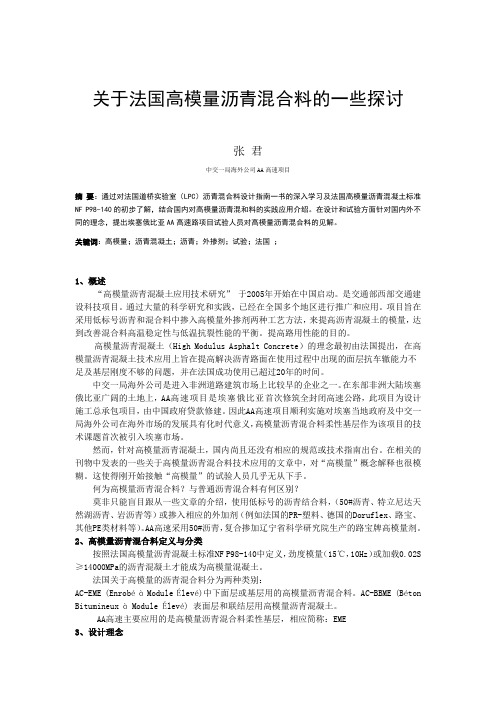
关于法国高模量沥青混合料的一些探讨张君中交一局海外公司AA高速项目摘要:通过对法国道桥实验室(LPC)沥青混合料设计指南一书的深入学习及法国高模量沥青混凝土标准NF P98-140的初步了解,结合国内对高模量沥青混和料的实践应用介绍。
在设计和试验方面针对国内外不同的理念,提出埃塞俄比亚AA高速路项目试验人员对高模量沥青混合料的见解。
关键词:高模量;沥青混凝土;沥青;外掺剂;试验;法国;1、概述“高模量沥青混凝土应用技术研究”于2005年开始在中国启动。
是交通部西部交通建设科技项目。
通过大量的科学研究和实践,已经在全国多个地区进行推广和应用。
项目旨在采用低标号沥青和混合料中掺入高模量外掺剂两种工艺方法,来提高沥青混凝土的模量,达到改善混合料高温稳定性与低温抗裂性能的平衡。
提高路用性能的目的。
高模量沥青混凝土(High Modulus Asphalt Concrete)的理念最初由法国提出,在高模量沥青混凝土技术应用上旨在提高解决沥青路面在使用过程中出现的面层抗车辙能力不足及基层刚度不够的问题,并在法国成功使用已超过20年的时间。
中交一局海外公司是进入非洲道路建筑市场上比较早的企业之一。
在东部非洲大陆埃塞俄比亚广阔的土地上,AA高速项目是埃塞俄比亚首次修筑全封闭高速公路,此项目为设计施工总承包项目,由中国政府贷款修建。
因此AA高速项目顺利实施对埃塞当地政府及中交一局海外公司在海外市场的发展具有化时代意义,高模量沥青混合料柔性基层作为该项目的技术课题首次被引入埃塞市场。
然而,针对高模量沥青混凝土,国内尚且还没有相应的规范或技术指南出台。
在相关的刊物中发表的一些关于高模量沥青混合料技术应用的文章中,对“高模量”概念解释也很模糊。
这使得刚开始接触“高模量”的试验人员几乎无从下手。
何为高模量沥青混合料?与普通沥青混合料有何区别?莫非只能盲目跟从一些文章的介绍,使用低标号的沥青结合料,(50#沥青、特立尼达天然湖沥青、岩沥青等)或掺入相应的外加剂(例如法国的PR-塑料、德国的Doruflex、路宝、其他PE类材料等)。
法国规范-水泥凝结时间检测
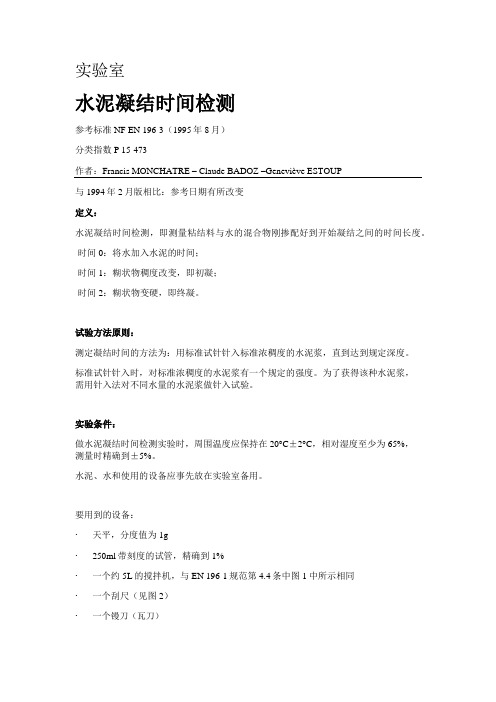
实验室水泥凝结时间检测参考标准NF EN 196-3(1995年8月)分类指数P 15-473作者:Francis MONCHATRE – Claude BADOZ –Geneviève ESTOUP与1994年2月版相比:参考日期有所改变定义:水泥凝结时间检测,即测量粘结料与水的混合物刚掺配好到开始凝结之间的时间长度。
-时间0:将水加入水泥的时间;-时间1:糊状物稠度改变,即初凝;-时间2:糊状物变硬,即终凝。
试验方法原则:测定凝结时间的方法为:用标准试针针入标准浓稠度的水泥浆,直到达到规定深度。
标准试针针入时,对标准浓稠度的水泥浆有一个规定的强度。
为了获得该种水泥浆,需用针入法对不同水量的水泥浆做针入试验。
实验条件:做水泥凝结时间检测实验时,周围温度应保持在20°C±2°C,相对湿度至少为65%,测量时精确到±5%。
水泥、水和使用的设备应事先放在实验室备用。
要用到的设备:∙天平,分度值为1g∙250ml带刻度的试管,精确到1%∙一个约5L的搅拌机,与EN 196-1规范第4.4条中图1中所示相同∙一个刮尺(见图2)∙一个镘刀(瓦刀)∙秒表,精确到十分之一秒∙维卡仪(水泥稠度仪)及其附件,见图3.图1-容器和搅拌机搅拌机应以图1中所示的速度运行:图3- 维卡仪维卡仪的构成竖直活塞①可移动,顶部装有托盘②,可在其上面放置可拆卸的荷载板③,在竖直活塞前面应有一个标尺④,标尺前面有一个指针⑤。
在活塞下部可装稠度试杆⑥或维卡试针⑦,维卡试针要配有持针器⑧,它们两个的质量应与稠度试杆相同。
托盘上不放东西时,“可移动部分+探头”或“可移动部分+探针+持针器”的重量应为300g±1g,托盘上防着荷载板时,其总重为1000g±2g。
∙稠度试杆:直径为10mm的光滑金属杆,下端为干净的圆形和方形截面。
∙维卡试针:光滑的金属杆,下端为1mm2干净的方形截面。
法国混凝土标准详述

钢筋混凝土用钢筋.焊接的适合性
(Concrete reinforcing bars. Suitability for welding.)
NF A35-019-1-1996
钢筋混凝土用钢筋.可焊刻痕丝制钢筋.第1部分:钢条和旋管
(Concrete reinforcing steels. Reinforcing steels made of weldable indented wires. Part 1 : bars and coils.)
NF A35-030-1996
钢制品.架空线路支持的混凝土杆用带改进粘附性的棒材
(Steel products. Bars with improved bond for concrete poles, supports for over head lines.)
NF A49-160-1979
钢管.混凝土包的加热板用的焊接钢管.(尺寸.交货技术条件.)
(Steels for concrete. Fabric composed of wires with a diameter lower than 5 mm.)
NF A35-027-2003
钢筋混凝土用钢产品.钢筋
(Steel products for reinforced concrete - Reinforcements.)
编号
中文名称
英文名称
NF A03-720-1-2002
混凝土的加筋和预应力用钢.试验方法.第1部分:加筋棒、钢丝杆和钢丝
(Steel for the reinforcement and prestressing of concrete - Test methods - Part 1 : reinforcing bars, wire rod and wire.)
法国混凝土标准

NF A35-015-1996
钢筋混凝 土用钢筋. (Concrete reinforcing steels. 可焊光面 Weldable round bars.) 钢筋 钢筋混凝 土用钢筋. 等级为 FeE500 的 可焊带筋 钢条和钢 旋管.由这 些钢筋制 成的钢筋 网 钢筋混凝
NF A35-016-1996
(Machines for the manufacture of constructional products from concrete and calcium-silicate Safety - Part 8 : machines and equipment for the manufacture of constructional products from calcium-silica)
NF F54-016-1973
装置.钢索 REINFORCED CONCRETE PICKETS.) 传动.钢筋 混凝土桩 铁路固定 设备.嵌入 钢筋混凝 土的轻型 槽电缆导 管系统
NF F55-050-1976
(FIXED RAILWAY INSTALLATIONS. SYSTEMS FOR LIGHT GAUGE ELECTRIC CABLE CONDUITS SET IN REINFORCED CONCRETE.)
(Steel for the reinforcement and prestressing of concrete - Test methods - Part 3 : prestressing steels.)
NF A05-668-2000
(Cathodic protection of steel in concrete.)
土用钢筋. weldable ribbed bars and wire rods.) 不可焊带 筋钢条和 线材 钢筋混凝 土用钢筋. (Concrete reinforcing bars. 焊接的适 Suitability for welding.) 合性
法国装饰混凝土模板的设计原则
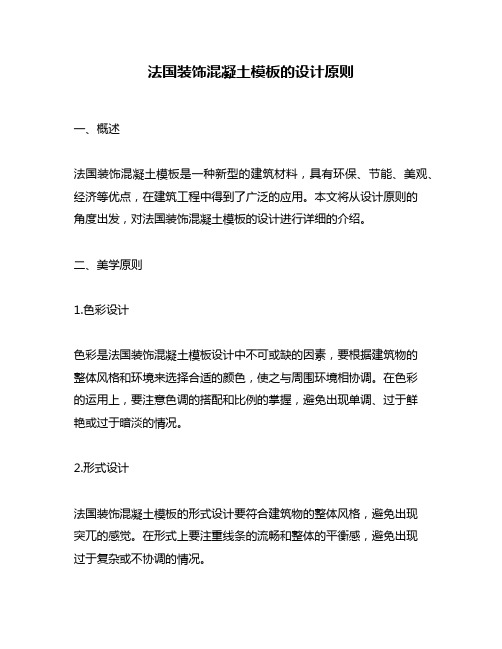
法国装饰混凝土模板的设计原则一、概述法国装饰混凝土模板是一种新型的建筑材料,具有环保、节能、美观、经济等优点,在建筑工程中得到了广泛的应用。
本文将从设计原则的角度出发,对法国装饰混凝土模板的设计进行详细的介绍。
二、美学原则1.色彩设计色彩是法国装饰混凝土模板设计中不可或缺的因素,要根据建筑物的整体风格和环境来选择合适的颜色,使之与周围环境相协调。
在色彩的运用上,要注意色调的搭配和比例的掌握,避免出现单调、过于鲜艳或过于暗淡的情况。
2.形式设计法国装饰混凝土模板的形式设计要符合建筑物的整体风格,避免出现突兀的感觉。
在形式上要注重线条的流畅和整体的平衡感,避免出现过于复杂或不协调的情况。
3.纹理设计纹理是法国装饰混凝土模板的一个重要元素,要根据建筑物的整体风格和环境来选择合适的纹理。
在纹理的运用上,要注重纹理的层次感和细节的处理,避免出现单调或过于花哨的情况。
三、施工原则1.模板的选择在施工中要选择质量好、规格合适的模板,避免出现模板变形、翘曲等情况。
模板的表面要平整、平滑,避免出现毛边、裂缝等情况。
2.模板的安装在安装模板时要严格按照设计要求进行,避免出现错位、偏移等情况。
模板的固定要牢固可靠,避免出现松动、脱落等情况。
3.混凝土的浇注在混凝土的浇注中要注意控制浇注速度和浇注厚度,避免出现混凝土塌陷、空鼓等情况。
浇注完毕后要及时进行养护,保持混凝土的湿润状态。
四、工程应用原则1.建筑物类型法国装饰混凝土模板适用于各种建筑物类型,但在应用时要根据具体情况进行选择。
对于高层建筑和大跨度建筑,要选择质量好、承载力强的模板进行施工。
2.环境要求法国装饰混凝土模板适用于各种环境要求,但在应用时要注意选择合适的材料和处理方式。
对于海边、山区等特殊环境,要选择具有抗腐蚀、抗风化等特性的模板进行施工。
3.施工周期在施工周期上,法国装饰混凝土模板的施工速度相对较快,但在施工中要注意控制施工周期,避免出现过长或过短的情况。
fr_FD_P_18-011

NORME FRANCAISE NF P 18-011juin 1992bétonsclassification des environnements agressifsE : concretes - classification of aggressive environmentsD : beton - klassifizierung von angreifenden umgebungenfascicule de documentation publié par l'afnor en juin 1992.remplace le fascicule de documentation de même indice, de mai 1985.correspondance A la date de publication, il existe des travaux européens traitant du même sujet.Ce fascicule de documentation ajoute à la définition de classe d'agressivité des milieux environnant le béton, des mesures préventives recommandées, au niveau de la confection du béton, pour lui assurer une bonne durabilité.Les publications étrangères ainsi que les travaux européens et internationaux ont été pris en considération lors de l'établissement de ce document, dont l'intérêt est reconnu, bien que les valeurs limites choisies restent très discutées entre experts. descripteurs Thésaurus International Technique : matériau de construction, béton armé, béton précontraint, durabilité, classification, environnement,protection contre les agents naturels, mesure de protection, attaque chimique, eau douce, milieu acide, milieu alcalin, milieu marin, eau de mer, salinité, ion, gaz solide, table de données.modifications Par rapport à l'édition précédente, modification des tableaux 5, 6 et 7 .Membres de la commission de normalisationPrésident : M TUTENUITSecrétaire : MME FERNANDEZ - AFNORM ADAM INGENIEUR CONSEILM ALEXANDRE CTPLM BENSIMHON CSTBM BESSET SNBPEM BILLHOUET SABLOCRETEM BOUINEAU CEBTPM BOUTIN SOCOTECM BROCHERIEUX SPIE BATIGNOLLESM BRUSIN CERIBM CHARONNAT LCPCM CLAUZON UNION NATIONALE DE LA MACONNERIEM COQUILLAT CEBTPM DELORT ATILHM GALLET EDFM GROSJEAN CH SYND ENTREPRENEURSM HAWTHORN UNIMIXM JACQUES LCPCM LAINE FIBM LARAVOIRE DAEIM LECAM EDF GDFM LEROUX LAFARGE BETONS GRANULATSM LESAGE LCPCMME MARMOTTAN SABLOCRETEM MIERSMAN SURSCHISTE SAM MONACHON CAMPENON BERNARDM NOVAK SIKA SAMME PAILLERE LCPCM PLUMAT ATILHM POITEVIN INGENIEUR CONSEILM SCHMOL SNBATIM THONIER FNTPM TUTENUIT CONSEIL GENERAL DES PONTS ET CHAUSSEES M VAUTRIN SETRAMLLE VINCENSINI AFNORSommaire1 objet2 références3 généralités4 nomenclature des environnements agressifs5 classification des environnements agressifs6 mode d'action des environnements agressifs6.1 liquides6.1.1 eaux douces6.1.2 solutions acides6.1.3 solutions basiques6.1.4 les solutions salines6.1.5 Cas particulier de l'eau de mer6.1.6 cas particulier des graisses et des huiles6.1.7 cas particulier d'une agression d'origine interne : la réaction alcalis-granulats 6.2 gaz6.2.1 anhydride sulfureux SO2 :6.2.2 acide sulfhydrique H2 S :6.2.3 anhydride carbonique CO2 :6.3 solides7 recommandations7.1 recommandations générales7.2 recommandations particulières8 bibliographie1 objetLe présent fascicule de documentation a pour objet :- de définir les environnements agressifs les plus courants vis-à-vis des bétons armés et bétons précontraints,- de donner des recommandations pour la confection de bétons résistant aux environnements agressifs.Il fournit au praticien les informations de base pour le choix des mesures préventives. Cependant, des études particulières sont nécessaires dans certains cas pour adapter ces mesures aux conditionsspécifiques de l'environnement.2 référencesP 18-584 Granulats - Réactivité potentielle de type alcali-silice.P 18-585 Granulats - Essai de stabilité dimensionnelle en milieu alcalin.NF T 90-036 Essais des eaux - Détermination de l'alcalinité (titre alcalimétrique et titrel'alcalimétrique complet).ASTM C 227 Test for potential alkali reactivity of cement - Aggregate combinations (mortar-bar method)ASTM C 289 Test for potential reactivity of aggregates (chemical method).3 généralitésLe béton fabriqué conformément aux règles de l'art est un matériau normalement durable si ses qualités intrinsèques sont adaptées au milieu auquel il est exposé.Les qualités intrinsèques d'un béton (compacité, perméabilité) qui conditionnent sa durabilité, sont en relation :- avec sa composition : catégorie de ciment, dosage en ciment, teneur en éléments fins, rapport eau/ciment (E/C), composition de l'eau de gâchage, texture, courbe granulométrique et nature minéralogique des granulats, adjuvants,- avec sa mise en oeuvre : mise en place, compactage, cure, enrobage des armatures.A l'agressivité des milieux définies au paragraphe 5 , correspondent ici trois niveaux de protection du béton décrits dans le tableau 1 .tableau 1 niveaux de protection4 nomenclature des environnements agressifsTrois catégories peuvent être distinguées :- milieux gazeux : gaz, vapeurs,- milieux liquides eaux douces, eaux de mer, solutions de sels, d'acides ou de bases, eaux résiduaires, liquides organiques (huiles, pétrole, solvants),- milieux solides : sols, produits de stockage. Ils agissent surtout par extraction ou dissolution, le plus souvent par l'eau des agents nocifs.L'agressivité du milieu dépend :- de la concentration de l'agent agressif,- de la viscosité (huiles),- de l'humidité relative. L'atmosphère peut être : sèche (H.R. < 60 %), humidité(60 % ≤ H.R.≤ 75 %), très humide (H.R. > 75 % ou lorsqu'un condensat peut se former à lasurface du béton). Le degré d'agressivité, notamment pour les gaz, augmente généralementavec l'humidité relative,- de la température : une élévation de température accroît les vitesses de réaction. Toutefois, dans le cas de l'attaque par les sulfates, les dégradations sont plus importantes à basse température. Par ailleurs, les effets du gel peuvent s'ajouter à ceux de l'attaque par lessulfates, les dégradations sont plus importantes à basse température. Par ailleurs, les effets du gel peuvent s'ajouter à ceux de l'attaque chimique,- de la pression (gaz, liquides).- de la mobilité du milieu (gaz, solutions) qui facilite le renouvellement de l'agent agressif et les échanges, et qui peut induire un effet mécanique supplémentaire (courant, vagues),- des cycles éventuels de température et d'humidité relative (variations journalières, saisonnières, zones de marnage) qui augmentent considérablement les vitesses dedégradation,- d'actions biologiques (micro-organismes, algues, bactéries).La dégradation du béton en milieu agressif est aussi fonction de la durée d'exposition.5 classification des environnements agressifsQuatre classes d'agressivité sont définies : environnements faiblement agressifs, moyennement agressifs, fortement agressifs et très fortement agressifs.Elles sont regroupées dans le tableau 2 .qui donne en outre leurs symboles, les mesures de protection et les niveaux de protection correspondants.tableau 2 définition des classes d'agressivitéle tableau 3 donne le degré d'agressivité des solutions et des sols les plus courants.tableau 3 agressivité de solutions et de solsSi plusieurs agents agressifs sont présents simultanément, la classe d'agressivité à prendre en compte est celle de l'agent dont la concentration ou le pH correspond au plus fort degré d'agressivité. Si les agents agressifs sont en concentrations inférieures à celles qui correspondent au degré faiblement agressif, l'environnement est considéré comme non agressif (Ao).Exemples :a) Béton en immersion totale dans l'eau de mer : environnement moyen agressif, niveau deprotection 2 :- ciment pour travaux à la mer (spécification COPLA) (1)- dosage en ciment ≥ 350 kg.m-3 (granulat D = 30 mm),- E/C ≤ 0,55.b) Béton dans une solution sulfatée de concentration 4 000 mg/l : environnement fortementagressif, niveau de protection 2 :- ciment résistant aux sulfates (spécification COPLA) (1)- dosage en ciment ≥ 350 kg.m-3 (granulat D = 30 mm),- E/C ≤ 0,50.NOTE(1)COmmission interministérielle Permanente des liants hydrauliques et des Adjuvants des bétons, mortiers et coulis du Ministère de l'Urbanisme, du Logement et des Transports.6 mode d'action des environnements agressifs6.1 liquides6.1.1 eaux doucesLes eaux pures ou très peu chargées peuvent dissoudre les constituants calciques du béton. La dissolution est accélérée en présence d'ions CI- et NA+ et retardée par les ions Mg++ et Ca++ . Les eaux dont le titre alcalimétrique complet (TAC) est inférieur à 1 mé/l sont faiblement agressives. 6.1.2 solutions acidesLes solutions acides sont caractérisées par un pH < 7. L'agressivité des acides minéraux ou organiques dépend de la solubilité des sels formés.Les acides minéraux libres (HCI, HNO3 , H2SO4) sont des acides forts ayant un effet dissolvant sur leciment et les granulats calcaires. L'acide sulfurique H2 SO4est doublement agressif par son acidité etpar la formation de sulfate qui donne naissance à des composés secondaires expansifs (ettringite). Pour l'acide carbonique contenu dans certaines eaux, la valeur du pH ne constitue pas un critère suffisant et la concentration de l'anhydride carbonique agressif doit être mesurée séparément.Les acides organiques libres, tels que les acides acétique, lactique, butyrique, formique contenus dans certaines eaux usées provenant des sucreries, papeterie, teintureries, conserveries, distilleries, tanneries, laiteries, etc, attaquent les constituant calcique du ciment. Ils sont généralement moins agressifs que les acides minéraux et peuvent même former des couches protectrices dans le cas des acides oxalique et tartrique par exemple. Toutefois, ces acides faibles peu dissociés peuvent être très agressifs vis-à-vis du béton malgré des pH peu inférieurs à 7 : leur neutralisation par des ions alcalins ou alcalino-terreux entraîne la permanence de la dissociation et par suite une importante émission cumulée d'ions H+ .Les acides humiques présentent moins de risques pour les bétons durcis. Mais, dans certains cas, ils peuvent échanger leurs ions H+ contre des cations de sels neutres et former ainsi des acides libres qui sont surtout des acides minéraux. Ils sont susceptibles également de retarder ou d'inhiber la prise du ciment.6.1.3 solutions basiquesLes solutions basiques sont caractérisée par un pH > 7. Les ciments Portland résistent généralement bien aux solutions basiques de concentration modérée (exemple NaOH < 10 %). Toutefois, desprécautions (durcissement suffisant, imperméabilité) doivent être prises si le béton est en contact par l'une de ses faces avec la solution, l'autre face étant soumise à l'évaporation. Dans ce cas,l'accumulation des sels peut provoquer des dégradations même pour de faibles concentrations.Les ciments avec ajouts résistent un peu moins bien à ces solutions que les ciments Portland. Les ciments alumineux sont détruits.6.1.4 les solutions salinesL'agressivité des solutions salines dépend des propriétés des produits formés (solubilité, expansion) qui sont en relation avec les types de cations et d'anions constitutifs des sels.6.1.4.1 cations- magnésium : (chlorure et sulfate) ils provoquent une réaction d'échange de base Ca++ Æ Mg++ qui aboutit à la dissolution partielle des constituants calciques du ciment et à laformation de Mg(Oh)2.- ammonium (chlorure, sulfate, nitrate) très nocifs, ils agissent également par échange de base.6.1.4.2 anions- Les sulfates : ils réagissent avec les aluminates du ciment en donnant des composésexpansifs : gypse CaSO4 , 2H2O et ettringite 3CaO.Al2O3.3CaSO4.31H2O dont lacristallisation peut provoquer la fissuration du béton.- Les nitrates : excepté le nitrate d'ammonium fortement agressif par l'action combinée de soncation, la plupart des nitrates sont faiblement agressifs.- Les chlorures : dans les bétons non armés, s'ils sont en forte quantité, ils peuvent être légèrement agressifs pour le ciment durci par l'influence qu'ils exercent sur la solubilité deses constituants. Dans les bétons armés et précontraints, le chlore est capable de détruire la protection alcaline des armatures et de provoquer leur corrosion.- Les sulfures : en présence d'air et d'humidité, leur oxydation peut conduire à la formation de sulfates. En milieu acide, il peut se former H2S qui par oxydation, donne de l'acide sulfurique très agressif.- les carbonates, phosphates, oxalates, fluorures : ils forment avec la chaux des composés insolubles et n'attaquent pas le béton.6.1.5 Cas particulier de l'eau de merLes dégradations du ciment par l'eau de mer sont dues essentiellement aux actions combinées des ions sulfates et des ions Mg++ telles qu'elles ont été décrites plus haute. La présence d'ions chlorures réduit notablement l'action des sulfates, mais agit sur les armatures.Dans les climats froids, l'agressivité des sulfates est accrue. Elle diminue légèrement dans les climats chauds alors que l'intensité des autres attaques augmente.Au total, l'attaque par l'eau de mer des bétons armés est plus sévère dans les climats chauds.L'eau de mer n'a qu'une action assez faible sur les bétons totalement immergés. Les bétons qui ne sont pas en contact direct avec l'eau de mer mais qui sont soumis aux embruns peuvent subir delégères dégradations. Les attaques les plus sévères ont lieu dans les zones de marnage et les zones aspergées.Aux actions chimiques de l'eau de mer peuvent s'ajouter l'action mécanique des vagues, l'effet du gel et les attaques biologiques.6.1.6 cas particulier des graisses et des huilesSi elles sont exemptes d'acides, leur agressivité vis-à-vis du béton imperméable est négligeable, les réactions de saponification donnent des produits insolubles protecteurs.Leur action dépend de la température qui modifie leur viscosité et leur possibilité de pénétration. Certaines huiles telles que les huiles de foie de morue, de baleine, de ricin, de noix de coco sont agressives et nécessitent une protection superficielle du béton.6.1.7 cas particulier d'une agression d'origine interne : la réaction alcalis-granulatsLes alcalins contenus dans la phase aqueuse interstitielle des bétons provenant soit du ciment, soit des granulats eux-mêmes ou encore du milieu extérieur sont susceptibles de réagir avec certains types de granulats et de compromettre la pérennité des ouvrages. Deux types de réactions peuvent se produire :6.1.7.1Réaction alcali-carbonate (dédolomitisation) avec les granulats dolomitique, qui se traduit par ladissolution superficielle du granulat et la formation de Mg (OH)2avec régénération de l'hydroxyde alcalin suivant les équations :CaMg(Co3 )2) + 2MOH Æ Mg(OH)2+ CaCO3+ M2CO3M2 CO3+ Ca(OH)2Æ 2MOH + CaCO3avec M = Li, Na, K.Ces réactions conduisent à la décohésion de l'interface pâte de ciment-granulat et à la fissuration du béton.6.1.7.2Réaction alcali-silice qui a lieu en présence de roches contenant des variétés de silice malcristallisées (opales, calcédoine, schistes, gneiss, certains granits altérés, quartzites, etc.). Elle conduit à la formation d'un gel de silicate calco-alcalin expansif.Les réactions alcalis-granulats sont en relation avec :- la teneur en alcalins du ciment.Les limites suivantes encore controversées sont indiquées : Na2O équivalent (2)≤ 0,6 % dans les ciments Portland,Na2O équivalent (2)≤ 0,9 % dans les ciments au laitier (> 50 % laitier),Na2O équivalent (2)≤ 2 % dans les ciments au laitier (> 65 % laitier).- la nature des granulats composition, texture, granularité, teneur en éléments réactifs (existence d'une teneur critique qui peut être de l'ordre de 3 à 5 % seulement).- l'humidité relative : c'est un facteur essentiel. Les réactions alcalis-granulats ont lieu généralement dans des milieux d'humidité relative > 85 %.- la température : aux environs de 40 °C, les réact ions sont très fortement accélérées.- les cycles d'humidification-dessiccation (gel-dégel, zones de marnage, variations saisonnières), accélèrent les réactions.- le temps : la fissuration du béton peut apparaître entre 5 et 40 ans.Chaque fois que les conditions d'environnement (température, humidité relative) sont favorables à une réaction alcalis-granulats, un contrôle de la réactivité potentielle des granulats doit être effectué (analyse pétrographique, reconnaissance des minéraux potentiellement réactifs, tests tels que ceuxprévus par les normes françaises P 18-584, P 18-585 les normes américaines ASTM C 289,ASTM C 227, ou autres).Dans l'état actuel des connaissances, la mesure préventive la plus efficace est l'utilisation de ciments composés : ciments contenant 30 % de pouzzolane réactive, ciments renfermant au moins 65 % de laitier.NOTE(2)Na2 O équivalent = Na2O + 0,658 K2O.6.2 gazLes gaz de combustion et les gaz rejetés par l'industrie peuvent contenir des acides minéraux libres, des acides organiques, de l'anhydride sulfureux, de l'acide sulfhydrique et de l'anhydride carbonique. Des solutions agressives peuvent se former lorsqu'on descend au-dessous du point de rosée. De plus les composants gazeux, non agressifs en eux-mêmes,peuvent se dissoudre dans l'eau (eau interstitielle du béton, eau de pluie, neige) et exercer une action nocive sur le béton : l'agressivité des gaz augmente fortement avec l'humidité relative du milieu (H.R. > 60 %).6.2.1 anhydride sulfureux SO2:son oxydation en présence d'humidité peut provoquer la formation d'acide sulfurique et de sulfates.6.2.2 acide sulfhydrique H2S :se rencontre dans les eaux thermales sulfureuses et ferrugineuses et surtout dans les eaux usées (égouts), peut également donner lieu par oxydation à la formation d'acide sulfurique et de sulfates.Une teneur supérieure à 5 mg/l de H2S est considérée comme agressive.6.2.3 anhydride carbonique CO2:la carbonatation du béton est favorisée lorsque le CO2est en présence d'humidité (50% ≤ H.R. ≤70 %). Elle a pour effet d'augmenter la résistance chimique du béton.Mais dans les bétons armés et précontraints, en présence d'humidité et d'oxygène, le CO2peut provoquer la dépassivation et la corrosion des armatures insuffisamment enrobées.6.3 solidesLes sols contenant des sulfates présentent les mêmes risques d'agressivité que les eaux riches en sulfates, s'ils sont humides.L'agressivité dépend de l'eau contenue dans le sol (niveau de la nappe, variations saisonnières, courant, porosité du sol), de la quantité et de la nature des sulfates qu'il renferme (le sulfate decalcium, peu soluble, est potentiellement moins dangereux que les sulfates de sodium et magnésium très solubles).Les sols marécageux peuvent contenir de l'acide carbonique, des acides organiques (acides humiques).Les décharges de déchets industriels, ordures ménagères, etc. peuvent renfermer des substances,déjà énumérées plus haut, susceptibles d'être entraînées par les eaux d'infiltration et d'attaquer lebéton.Les sols dont l'acidité mesurée suivant BAUMAN-GULLY est ≥ 20 sont faiblement agressifs (acidité BAUMAN-GULLY = nombre de cm3 d'acide 0,1 N libéré par 100 g de sol lors du traitement avec200 cm3 d'une solution 0,1 N d'acétate de sodium neutre).7 recommandations7.1 recommandations généralesLes recommandations générales pour fabriquer un béton résistant aux attaques chimiques sontrésumées dans le tableau 4 .tableau 4 recommandations généralesIl convient par ailleurs, d'attacher une attention particulière à la cure du béton avant son exposition au milieu agressif. La température et l'humidité relative pendant la confection sont les deux paramètres les plus importants conditionnant les performances à long terme du béton. Le risque d'évaporation excessive est maximum par temps chaud. Par temps froid le processus est moins rapide maisl'hydratation est également plus lente. Une cure insuffisante aura des conséquences néfastes sur la perméabilité, les résistances et la durabilité du béton.L'eau de mer ne doit pas être utilisée comme eau de gâchage dans les bétons armés.Dans la mesure du possible, les éléments de structures trop minces et les angles vifs doivent êtreévités.La compacité et la perméabilité du béton sont en relation respectivement avec la teneur en éléments fins (≤ 80 µm) et leur réactivité.7.2 recommandations particulièresLes recommandations particulières concernant le choix du ciment en fonction de la nature et du degré d'agressivité sont données dans les tableaux 5, 6 et 7 respectivement pour les milieux contenant des sulfates, l'eau de mer et les solutions acides.tableau 5 milieux contenant des sulfates (sols ou solutions), recommandations pour le choix du ciment.tableau 6 eau de mer, recommandations pour les choix du cimenttableau 7 milieux acides, recommandations pour le choix du cimentLe tableau 8 donne à titre indicatif les limites en chlore admissibles dans les bétons armés et non armés, compte-tenu des chlorures extérieurs qui pourraient diffuser dans un béton perméable.tableau 8 teneurs limites en ions chlore dans les bétons armés et non armés (% de la masse de ciment)8 bibliographie1 BICZOK I, « Concrete corrosion, concrete protection ». Akadémiai, Kiodo, Budapest(1972).2 CEMBUREAU, « Use of Concrete in agressive environments ».U.D.C.389.6.666.94.620.193.25/27, janvier 1978.3 Norme DIN 4030, TMS l'eau, avril 1979, pp.227-240, « Appréciation de l'agressivité deseaux, des sols et des gaz vis-à-vis du béton ».4 Technical Note TN 37 Australia, Cement and Concrete Association of Australia« Durability of Concrete Structure », (Nov. 1980).5 Building Research Establishment digest, digest 250, (Juin 1981, Concrete in sulfate-bearing soils and groundwaters ».6 Recommandation RILEM 32 RCA, « Sea-Water attack on Concrete and PrecautionnaryMeasures », à paraître.ISO/TC 71/SC 3N 143 Classification of chemically agressive environmental conditionsaffecting concrete.8 ISO/TC 71:SC 3N 144 Classification of climatic actions of environmental conditionsaffecting concrete.9 ISO/TC 71/SC 3N 145 Classification of environmental exposure conditions for concretestructures.10 Nomenclature RILEM 32 RCA, (1981). « Résistance chimique du béton » Mater etConstr., Vol. 14, n° 80.11 Bulletin CEB n° 148, (Février 1982), « Durabili ty of concrete Structures ».12 KLEINLOGEL A., « L'influence des divers éléments physico-chimiques sur les bétons »,DUNOD, Paris, (1960).13 Bulletin du ciment (Suisse)(fév. 1982), « Action de diverses substances sur le béton ».14 BAEL83 Règles techniques de conception et de calcul des ouvrages et constructionsen béton armé, suivant la méthode des états limites.15 Fascicule 65 du CCTG « Exécution des ouvrages et constructions en béton armé ouprécontraint ».16 DTU 21.4 Prescriptions techniques concernant l'utilisation du chlorure de calcium etdes adjuvants contenant des chlorures dans la confection des coulis, mortiers et bétons.Liste des documents référencésRègles BAEL 91 révisées 99 (DTU P 18-702) (mars 1992, février 2000) : Règlestechniques de conception et de calcul des ouvrages et constructions en béton armé,suivant la méthode des états limites (fascicule 62, titre 1er, section I du CCTG) (Cahiers CSTB 3192)DTU 21.4 : Utilisation du chlorure de calcium et des adjuvants contenant des chlorures dans la confection des coulis, mortiers et bétons - Prescriptions techniques。
混凝土强度标准的历史演变

混凝土强度标准的历史演变混凝土强度标准的历史演变一、混凝土强度标准的起源混凝土作为一种重要的建筑材料,其强度标准的制定关系到工程建设的质量和安全。
最早的混凝土强度标准可以追溯到19世纪初期,当时的标准主要基于实验室试验数据和经验值。
二、早期的混凝土强度标准19世纪初期,欧洲的实验室开始对混凝土的强度进行测试,并制定了一些基于经验值的强度标准。
例如,1836年英国的工程师John Smeaton在他的实验室中对混凝土进行了试验,并得出了一个基于经验法则的强度标准。
他认为,混凝土的强度取决于其成分、制备方法和养护条件。
他提出的混凝土强度标准是“按照尽可能多的方法进行实验,得出可靠的结果,并根据这些结果确定混凝土的强度”。
此后,欧洲各国陆续制定了自己的混凝土强度标准。
例如,法国制定了一个基于试验数据的标准,其强度等级分为P1、P2、P3等级,其中P1级为最高级别,表示混凝土的抗压强度大于200kg/cm2。
德国在1896年制定了一份新的混凝土强度标准,该标准强调了混凝土的成分和制备方法对强度的影响,并采用了一种新的逐步加载试验方法。
三、现代混凝土强度标准的发展20世纪初期,随着工程建设的不断发展,对混凝土强度标准的要求也越来越高。
为了满足工程建设的需要,各国纷纷对早期的混凝土强度标准进行修改和完善。
1.美国混凝土标准美国混凝土标准是全球最早的混凝土标准之一。
在20世纪初期,美国的混凝土标准主要依据于实验室试验数据和经验值,但这种标准的缺点是不能保证混凝土的强度和质量。
因此,美国开始制定基于统计学方法的混凝土标准,这种标准将试验数据和经验值结合起来,更加准确地评估混凝土的强度和质量。
2.欧洲混凝土标准欧洲混凝土标准是在20世纪中期制定的。
该标准采用了一种新的试验方法,即逐步加载试验方法,这种方法可以更加准确地评估混凝土的强度。
欧洲混凝土标准还规定了混凝土的强度等级和抗压强度的计算方法,这些规定对于保证工程建设的质量和安全具有重要的意义。
法国薄层沥青混凝土BBMa 0/10在工程实践中的应用
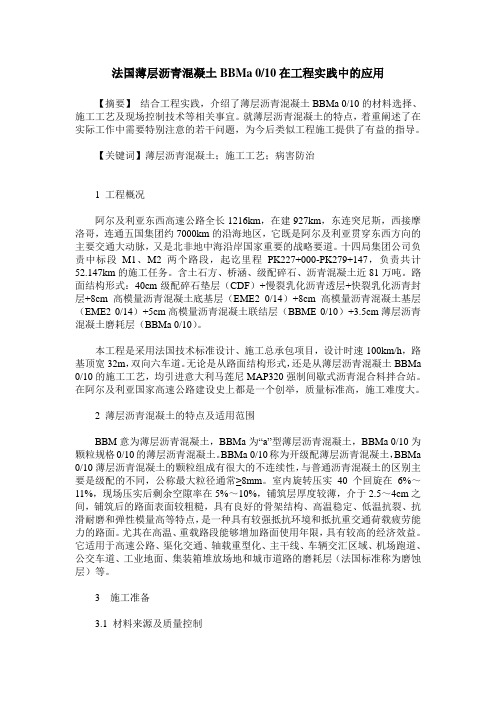
法国薄层沥青混凝土BBMa 0/10在工程实践中的应用【摘要】结合工程实践,介绍了薄层沥青混凝土BBMa 0/10的材料选择、施工工艺及现场控制技术等相关事宜。
就薄层沥青混凝土的特点,着重阐述了在实际工作中需要特别注意的若干问题,为今后类似工程施工提供了有益的指导。
【关键词】薄层沥青混凝土;施工工艺;病害防治1 工程概况阿尔及利亚东西高速公路全长1216km,在建927km,东连突尼斯,西接摩洛哥,连通五国集团约7000km的沿海地区,它既是阿尔及利亚贯穿东西方向的主要交通大动脉,又是北非地中海沿岸国家重要的战略要道。
十四局集团公司负责中标段M1、M2两个路段,起讫里程PK227+000-PK279+147,负责共计52.147km的施工任务。
含土石方、桥涵、级配碎石、沥青混凝土近81万吨。
路面结构形式:40cm级配碎石垫层(CDF)+慢裂乳化沥青透层+快裂乳化沥青封层+8cm高模量沥青混凝土底基层(EME2 0/14)+8cm高模量沥青混凝土基层(EME2 0/14)+5cm高模量沥青混凝土联结层(BBME 0/10)+3.5cm薄层沥青混凝土磨耗层(BBMa 0/10)。
本工程是采用法国技术标准设计、施工总承包项目,设计时速100km/h,路基顶宽32m,双向六车道。
无论是从路面结构形式,还是从薄层沥青混凝土BBMa 0/10的施工工艺,均引进意大利马莲尼MAP320强制间歇式沥青混合料拌合站。
在阿尔及利亚国家高速公路建设史上都是一个创举,质量标准高,施工难度大。
2 薄层沥青混凝土的特点及适用范围BBM意为薄层沥青混凝土,BBMa为“a”型薄层沥青混凝土,BBMa 0/10为颗粒规格0/10的薄层沥青混凝土。
BBMa 0/10称为开级配薄层沥青混凝土,BBMa 0/10薄层沥青混凝土的颗粒组成有很大的不连续性,与普通沥青混凝土的区别主要是级配的不同,公称最大粒径通常≥8mm。
室内旋转压实40个回旋在6%~11%,现场压实后剩余空隙率在5%~10%,铺筑层厚度较薄,介于2.5~4cm之间,铺筑后的路面表面较粗糙,具有良好的骨架结构、高温稳定、低温抗裂、抗滑耐磨和弹性模量高等特点,是一种具有较强抵抗环境和抵抗重交通荷载疲劳能力的路面。
- 1、下载文档前请自行甄别文档内容的完整性,平台不提供额外的编辑、内容补充、找答案等附加服务。
- 2、"仅部分预览"的文档,不可在线预览部分如存在完整性等问题,可反馈申请退款(可完整预览的文档不适用该条件!)。
- 3、如文档侵犯您的权益,请联系客服反馈,我们会尽快为您处理(人工客服工作时间:9:00-18:30)。
NF B40-376-1986
耐火制品.非异型预制材料.密实和隔热的混凝土.稠度试验
NF C67-250-1981
架空线.支柱.预应力混凝土电杆.规格
(Supports for overhead lines. Prestressed concrete poles. Specification.)
NF E58-610-2000
由混凝土和钙硅而来的构架产品生产的机器.安全.第1部分:共同要求
(Cathodic protection of steel in concrete.)
NF A35-015-1996
钢筋混凝土用钢筋.可焊光面钢筋
(Concrete reinforcing steels. Weldable round bars.)
NF A35-016-1996
钢筋混凝土用钢筋.等级为FeE500的可焊带筋钢条和钢旋管.由这些钢筋制成的钢筋网
NF B51-301-1996
混凝土连接碎料板.耐霜冻性的测定
(Cement bonded particleboards. Determination of frost resistance.)
NF C67-200-1981
架空线支柱.钢筋混凝土电杆.规格
(Supports for overhead lines. Reinforced concrete poles. Specification.)
NF A35-021-1998
混凝土用钢材.用于增强钢制备的可焊接金属线
(STEELS FOR CONCRETE. WELDABLE WIRES USED FOR THE FABRICATION OF REINFORCING STEELS.)
NF A35-024-1998
混凝土钢材.由直径小于5mm的金属线构成的织物
混凝土的钢筋和预应力用钢.试验方法.第3部分:预应力钢
(Steel for the reinforcement and prestressing of concrete - Test methods - Part 3 : prestressing steels.)
NF A05-668-2000
混凝土中钢筋的阴极爱护
NF A35-019-2-1996
钢筋混凝土用钢筋.可焊刻痕丝制钢筋.第2部分:焊接钢筋网
(Concrete reinforcing steels. Reinforcing steels made of weldable indented wires. Part 2 : welded fabric.)
(Refractory products. Prepared unshaped materials. Dense and insulating castables. Consistency test.)
NF B51-300-1995
混凝土连接碎料板.硬体冲击阻力测定
(CEMENT-BOቤተ መጻሕፍቲ ባይዱDED PARTICLEBOARDS. DETERMINATION OF HARD BODY IMPACT RESISTANCE. (EUROPEAN STANDARD EN 1128).)
NF A35-030-1996
钢制品.架空线路支持的混凝土杆用带改进粘附性的棒材
(Steel products. Bars with improved bond for concrete poles, supports for over head lines.)
NF A49-160-1979
钢管.混凝土包的加热板用的焊接钢管.(尺寸.交货技术条件.)
NF A35-018-1984
钢筋混凝土用钢筋.焊接的适合性
(Concrete reinforcing bars. Suitability for welding.)
NF A35-019-1-1996
钢筋混凝土用钢筋.可焊刻痕丝制钢筋.第1部分:钢条和旋管
(Concrete reinforcing steels. Reinforcing steels made of weldable indented wires. Part 1 : bars and coils.)
(Steels for concrete. Fabric composed of wires with a diameter lower than 5 mm.)
NF A35-027-2003
钢筋混凝土用钢产品.钢筋
(Steel products for reinforced concrete - Reinforcements.)
NF A03-720-2-2002
混凝土的钢筋和预应力用钢.试验方法.第2部分:焊接纤维
(Steel for the reinforcement and prestressing of concrete - Test methods - Part 2 : welded fabric.)
NF A03-720-3-2002
(Concrete reinforcing steels. Weldable ribbed bars and coils of grade FeE500. Fabric made of these reinforcements.)
NF A35-017-1996
钢筋混凝土用钢筋.不可焊带筋钢条和线材
(Concrete reinforcing steels. Nonweldable ribbed bars and wire rods.)
编号
中文名称
英文名称
NF A03-720-1-2002
混凝土的加筋和预应力用钢.试验方法.第1部分:加筋棒、钢丝杆和钢丝
(Steel for the reinforcement and prestressing of concrete - Test methods - Part 1 : reinforcing bars, wire rod and wire.)
